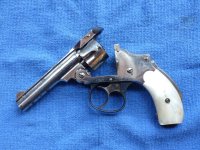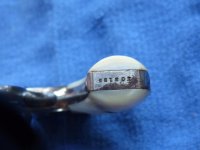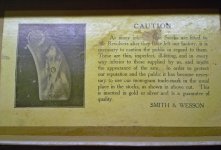That 32 Safety was shipped around 1901-1902 and could have potentially had gold medallion MOPs. The company began a big push to make sure the buyer was getting premium quality pearl stocks by very early in the Twentieth Century. Partly because they got extra money for the pearl stocks and they wanted the customers to only buy their products. By 1900, large distributors routinely added these stocks, but they were marginal in quality and much thinner than factory. I assume the owners never knew where the stocks originally came from, so if they did not like the quality or feel, plus if the broke, the first place they would complain was the factory. By the very early 1900's, the catalogs and many boxes showed images of the medallion stocks and warned the customer about cheap imitations. The 1900 S&W catalog, however, showed non-medallion pearls and the 1903 catalog not only showed the medallion stocks, but also warned the customer about cheap imitations (see below image).
Having said this, Mike is right is asking the question for a gun made that early in the Twentieth Century. Since the company did not advertise medallions in 1900 and did advertise them in 1903, it is very possible that you could have factory stocks. Authenticating them is a visual task and looking closely at the fit and finish helps. The only other thing to check is to measure the thickness of the stocks towards the bottom. Measure at the thickest point and compare that measurement to the hard rubber stocks of the 32 Safety. Measuring my spare hard rubber stocks for that model, I find they average .355". Slight differences in thickness was due to the fact that each stock was sanded on the back to fit to the frame, resulting in a perfect fit, but also a small difference in thickness. If your pearls are close to .35" thick, they are most likely original to the gun. The fit to your frame looks perfect, they are aged appropriately for gun and if original, are valuable. A Letter of Authenticity is the only way to know if your revolver left the factory with pearls, but if you are going to keep it in the family, you should get that letter.
Pearl stocks back then were very expensive, the factory charged $2.50 in 1900 for 32 stocks and only $2.25 for ivory. They only charged $11.75 for the whole gun!!






